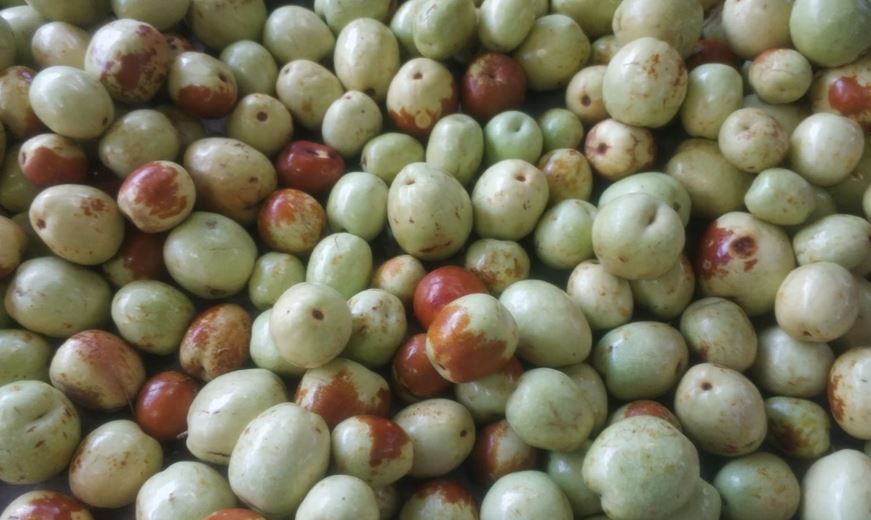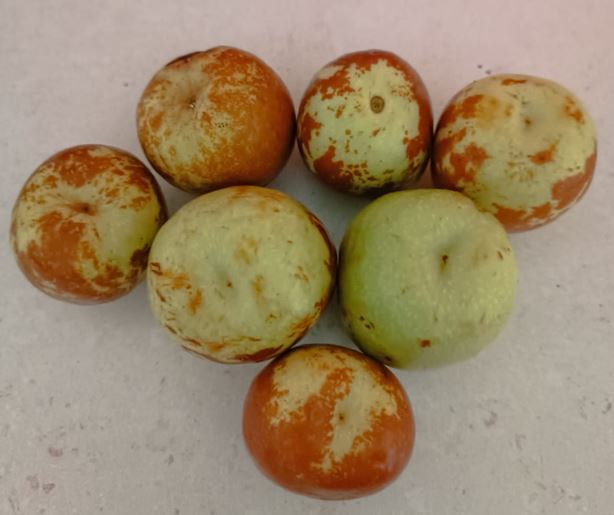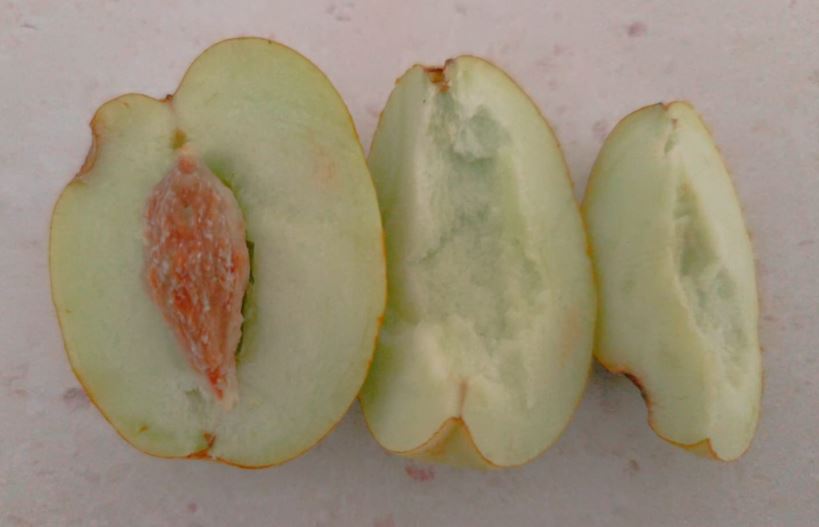Jujube fruit has a history of approximately 4000 years. Its name in the literature is Zizyphus jujuba Mill. Other names of jujube known among the public are “Chinese date fruit” or “red date fruit“. It is known as the “fruit of life” and “fruit of immortality” in China.

Jujube, known to belong to the Rhamnaceae family, is a temperate climate plant that can grow widely in tropical and subtropical climates. Its homeland is East Asia, especially China.
The jujube tree can grow up to 8 to 10 meters and sheds its leaves in winter. Its flowers bloom between April and May and are yellow and have a pleasant scent.
Jujube tree, which is reported to be suitable for temperate climatic conditions, can be cultivated in gardens and it is also reported that there are wild species in natural environments. The Jujube tree is a tree that is generally resistant to cold weather conditions. However, if it encounters cold weather during the flowering period, it suffers extreme damage from frost.
Jujube tree has no soil selectivity except in hefty soils. It can grow in acidic or slightly basic (pH 5-7.5) soils. It is resistant to drought as well as cold weather conditions. However, to grow productive fruit trees, choosing sandy, permeable, and moist soils with sufficient humus content is recommended.
Jujube tree does not require excessive care, as with delicate fruits. Although this plant does not require much water, it is known to prefer soil rich in lime.
Jujube is generally propagated by seeds or grown by grafting on seedlings. However, the production method from seed is complex, and output can be done with tube-grafted saplings instead. There are many studies and research on propagation under in-vitro conditions, but only some studies on propagation with steel. It is seen that it spontaneously reproduces wildly within the natural vegetation of some regions.
Jujube fruit is olive green initially but turns reddish brown over time as it ripens. The ripe fruit has an elliptical shape close to an egg shape with a fragile shell.

In addition, jujube fruit has a sweet, juicy, and light aroma. The pulp part of the fruit is yellow and has a single seed. Jujube ripens between August and September, depending on the season and weather conditions, and can be dried and stored if desired.


Jujube fruit can be consumed dried or as fresh fruit. However, it is recommended that the drying process be carried out in the sun and open-air conditions. It is common to consume it as a treat in daily use (hosting guests), as a snack or appetizer, and as a nut for breakfast.
In addition to the methods listed here, jam, vinegar and candy are also made. In addition, it is used as fruit juice, fruit tea, herbal powder drink, fruit-based tablet, or as a sweetener/flavoring agent in fruit teas.
It is reported that jujube fruit is an additive in traditional and alternative medicine practices. It is stated that the fruits that are not consumable for people are quality animal feed raw material.
If we look at its history briefly, Jujube was brought to America in the 1800s and later found broad areas in Europe, Australia, South and East Asia. Today, more than 90% of the world’s Jujube fruit production is made by China.
Jujube cultivation can be done in Turkey’s Marmara, Western and Southern Anatolia regions. To be more specific, it is grown in the provinces of Antalya, Isparta, Mersin, Kayseri, Hatay, Bursa, and Çanakkale, but it is naturally distributed only in Çivril district of Denizli province. According to TÜBİVES (Turkish Plant Data Service, An Institute in Turkey) data, the distribution of this plant in Turkey is the Northern Anatolia region.
Benefits of Jujube Fruit for Human Health
Jujube fruit has a very high potential to be used to protect our health and treat diseases. It is known that jujube has been consumed since ancient times as a nutritious food that has an important place in traditional medicine in eastern countries. Today, jujube is used as a raw material in the food and pharmaceutical industries.
The known benefits of jujube fruit are as follows;
• Dried jujube fruits are boiled in water to treat stomach disorders.
• It protects the liver,
• It helps relieve cardiovascular diseases,
• It suppresses cancer cell proliferation,
• It helps eliminate blood cholesterol irregularities,
• It contains tannin and mucilaginous substances; therefore, people with diabetes can consume fresh jujube fruit.
• In addition to the ones mentioned here, it is also known among the public to be used as an expectorant, chest softener and diuretic.
• In addition to the fruit pulp, jujube seeds are also used as an insomnia reliever, tonic, sedative,
• It may have a positive effect against diseases such as diarrhea, wounds in the stomach and intestines, jaundice and ulcers,
• It has anti-inflammatory and anti-infective, pain-relieving and therapeutic benefits in secondary bacterial disorders,
• It is reported to be very effective in the treatment of intestinal worms.
However, excessive consumption of jujube fruit may cause some adverse effects and side effects, such as low blood pressure, nausea and bloating, fluctuation in blood sugar, and itching on the skin. It is recommended to consume 1 to 4 jujubes a day. It is recommended to consult a doctor for jujube consumption during pregnancy and breastfeeding.
Composition of Jujube Fruit
The main reason why Jujube can provide the benefits listed above is that it is very rich in vitamins, minerals and phenolic compounds. In addition, the fact that Jujube has different enzymes and components makes it very beneficial for health.
Regarding major ingredients, 100 grams Jujube fruit contains 20 grams carbohydrates (mostly dietary fiber), 1,2 grams protein and 0,2 grams fat, and 100 grams Jujube fruit provides approximately 79 kcal energy. Jujube contains high amounts of dietary fiber, which helps regulate digestive problems.
In terms of vitamins, Jujube stands out with its high vitamin C content (70 mg/100 g), which is equivalent to citrus fruits. Jujube is a fruit that is also very rich in vitamin A. The high amount of these vitamins, which have high antioxidant activity, helps Jujube strengthen the immune system and increases its anti-cancer and anti-aging effects.
Jujube fruit also contains niacin (vitamin B3) and riboflavin (vitamin B2). The mentioned vitamins are very important for the body’s hormone and enzyme system.
Jujube is also very rich in minerals. Zinc (Zn), magnesium (Mg), copper (Cu), phosphorus (P), potassium (K), sodium (Na), and iron (Fe) are the main minerals found in Jujube. The mineral found in the highest amount in Jujube is potassium (250 mg/100 g), and the high content of potassium helps regulate blood pressure.
The component that makes Jujube beneficial to the respiratory tract is a particular enzyme called “bromelain“.
In addition to these components, Jujube also contains other medicinal components such as sterols, alkaloids, saponins, serotonin and triterpenoids.
On the other hand, studies on Jujube, which is not well known and consumed worldwide, are limited. For example, changes in biochemical composition during drying have yet to be investigated. This is an important issue because it is known that the dried form of the fruit is consumed a lot. In other words, the fresh form of this fruit contains a very high amount of vitamin C, but this fruit is dried and consumed mostly as nuts.
For these and similar reasons, Jujube needs to be researched more. However, Jujube, whether dry or fresh, is a beneficial fruit and its consumption is beneficial to health.
References
Kavas, İ. ve Dalkılıç, Z. (2015). Bazı hünnap genotiplerinin morfolojik, fenolojik ve pomolojik özelliklerinin belirlenmesi ve melezleme olanaklarının araştırılması. ADÜ Ziraat Fak. Dergisi 12(1):57-72. (In Turkish)
Preeti, T. S. (2014). “Ziziphus Jujuba: A Phytopharmacological Review”. International Journal of Research and Development in Pharmacy and Life Sciences, 3:3, 959-966.
Qing-Han Gao, Chun-Sen Wu, and Min Wang. (2013). The Jujube (Ziziphus Jujuba Mill.) Fruit: A Review of Current Knowledge of Fruit Composition and Health Benefits. Journal of Agricultural and Food Chemistry. 61 (14), 3351-3363.
Zhumatov, U.Z. (1996). “Elementary compositions of the fruits of Morus nigra and Zizyphus jujuba and the Chemistry of Natural Compounds C/C of Khimiia” Chemistry of Natural Compounds volume 32, pages 100–101.
Here is another little-known fruit that is very beneficial to health;
Black Rosehip; Overview, Composition and Health Benefits

Be First to Comment